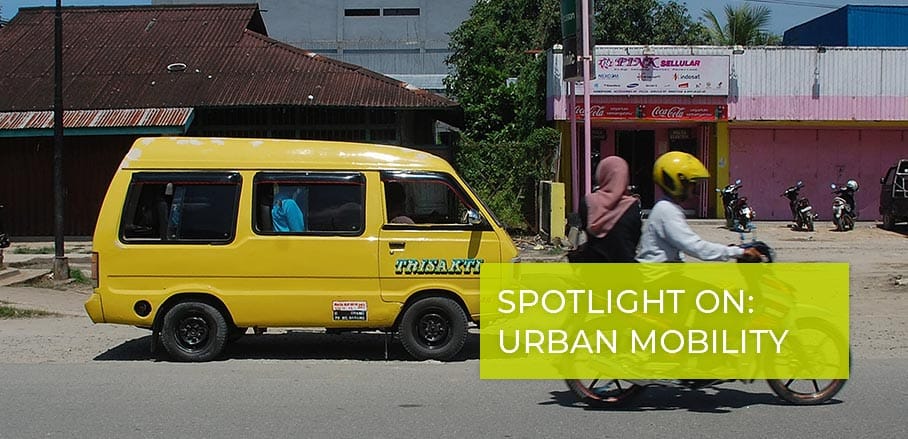A New and Better Normal for Urban Mobility in Indonesia
Indonesia is not spared from the COVID-19 global pandemic. For urban mobility planners, however, this unfortunate pandemic presents a unique opportunity to reflect on our public transport efficiency and resiliency strategies and shape a new and better normal.
In any city, the COVID-19 pandemic affects public transport systems, and Jakarta is no exception. The good news is that facemask mandates and physical distancing measures seem to have worked: in early May, authorities conducted PCR testing on randomly sampled 325 asymptomatic commuter-rail passengers and only three came out positive; indicating a less than one per cent prevalence rate in the what used to be the busiest urban rail line in the country.
Daily ridership had dropped to about 15 per cent at the time of testing as a result of work from home and travel restriction measures. In mid-March, the Governor-Mayor of Jakarta followed the President’s call to voluntary work from home with cutting transit services. As a result of large-scale social restrictions, TransJakarta, the municipal bus operator, is running only at ten per cent of their pre-pandemic seat-kilometre capacity.
The Challenges
Service cuts allow TransJakarta to divert resources to join the fight against the pandemic. Busses are shuttling medical professionals from hospitals to their government-funded temporary hotels. However, these conditions are not sustainable in the long run. The pandemic-induced economic contraction is hitting public transportation in several ways.
First, farebox revenue is dropping since riders are now working from the safety of their homes. Extra spending is necessary for pandemic proofing, such as hand sanitisers, thermometer guns, disinfectant sprays, and facemasks and protective gears for workers.
Second, public transportation may suffer from the cascading effect of a significantly moderated growth. Government subsidy accounts for a significant portion of public bus and mass rapid transit operations; this may get cut as the government is expected to reallocate budget for pandemic response while general revenue is shrinking.
Studies show that socially optimal service frequencies are higher than the ones that maximise operators’ profit and that subsidies are required to achieve the socially desirable levels of service. Private sector operators do not have society’s best interest in mind; unless governments agree that public transportation is an essential service, long term service cuts may have lasting effects.
In the short run, these cuts may manifest in passengers waiting longer, which in turn may result in passengers shifting away to private modes, incurring long-term losses which may wipe out 15 years of transport transformation.
A Difficult Choice
Given the ongoing pandemic and the potential harm from economic slowdown, we are faced with a difficult choice of balance between lives and livelihoods. Like Jakarta, all global cities need a strategy to safely reopen the economy while keeping the health and human costs as low as possible. After eight weeks of working from home and large-scale social restrictions, a new and better normal couldn’t come soon enough to Indonesia.
What will this New Normal Entail?
First, we need to understand that it is unlikely that we are returning to our pre-pandemic status quo, at least until a viable vaccine is readily available. Physical distancing measures, hand sanitisers, and facemasks will not fall out of fashion anytime soon. If anything, this is going to be part of our new public space etiquette, as is the case in post-SARS Hong Kong and Taiwan. Along with possible closures of wet markets and unhygienic on-site animal slaughter, perhaps we need to enforce no-spitting rules just like we ban smoking in public spaces.
Second, public transport regulators and managers will have to rebalance efficiency and resiliency. Physical distancing implies more space per passenger, which translates to a reduced load factor and lower farebox revenue. With more space in between passengers, operators will need to increase capacity to transport the same levels of passengers. As such, we may need new and improved Key Performance Indicators (KPIs) to better reflect the importance of resiliency in bus and mass rapid transit operations.
Likewise, regulators and managers may need public health officers or epidemiologists to monitor health risks and inform operational decisions. These include an aggressive testing strategy that will serve as an early warning system. Furthermore, we are still learning new things about the virus, SARS-CoV-2, on a weekly basis. For example, facemask wearing guidelines were reversed in a matter of weeks after experts agree that putting on sub-medical grade facemasks is better than not wearing one at all. In house public health expertise may help keep up with these dynamics.
Third, governments must reaffirm their commitment to funding public transportation as an essential service. Universal basic mobility is a fundamental human right. Bus and mass rapid transit must continue to be adequately resourced, especially during these challenging times. Subsidy cuts should not be an option as the resulting lower service frequency may reverse years of hard-won gains in our urban mobility programs. It will be very hard to regain the trust of disgruntled passengers.
Lastly, on a more encouraging note, our new work-from-home routine may actually improve our urban mobility performance, productivity, and overall quality of life. One of the persistent problems with urban mobility is that demand is sharply peaked, overwhelming capacity and congesting roads in the early morning and late afternoon hours.
Working-from-home options may reduce overall trip rates and allow for a more flexible arrival time in the physical workplace. As such, working from home may help us flatten the commuting curve long after it has helped us flatten the epidemic curve.
Some global cities, such as London, New York, Paris, and Berlin, are expanding bike lanes to accommodate the most sustainable form of mobility. While, unfortunately, the same cannot be said about Jakarta or other Indonesian cities, we can still hope for a cycling resurgence to complete our new and better urban mobility normal.
- A New and Better Normal for Urban Mobility in Indonesia - 20. May 2020
